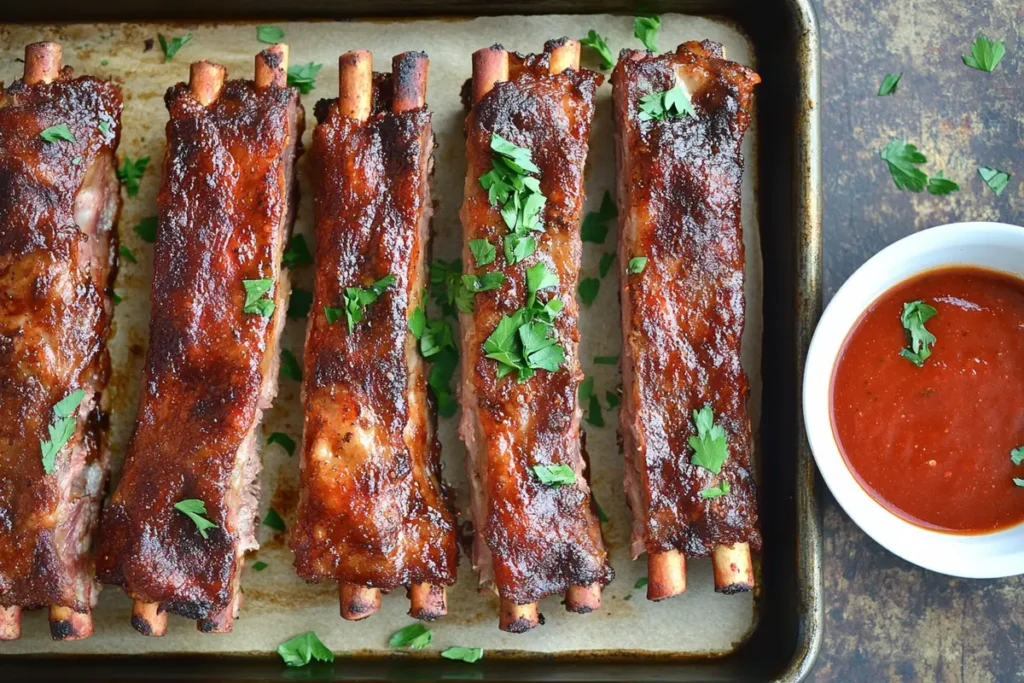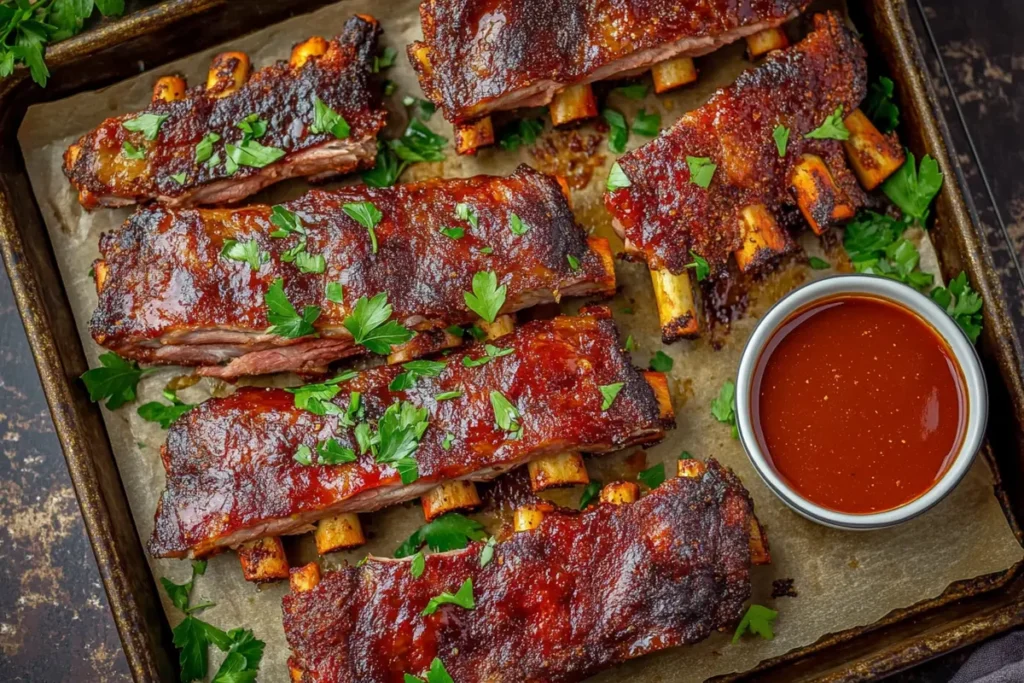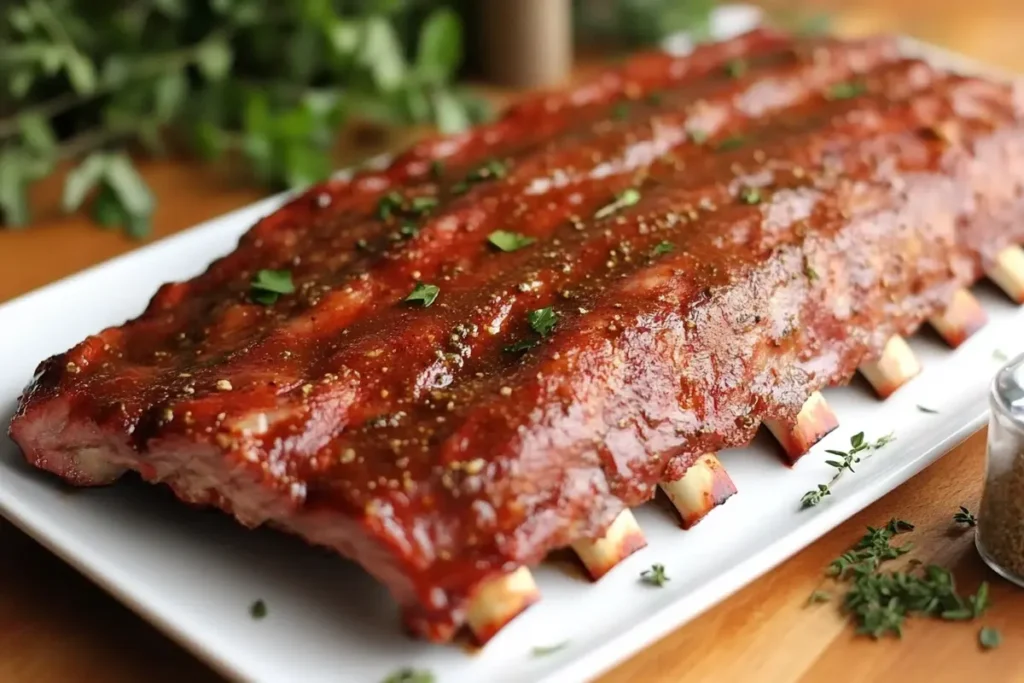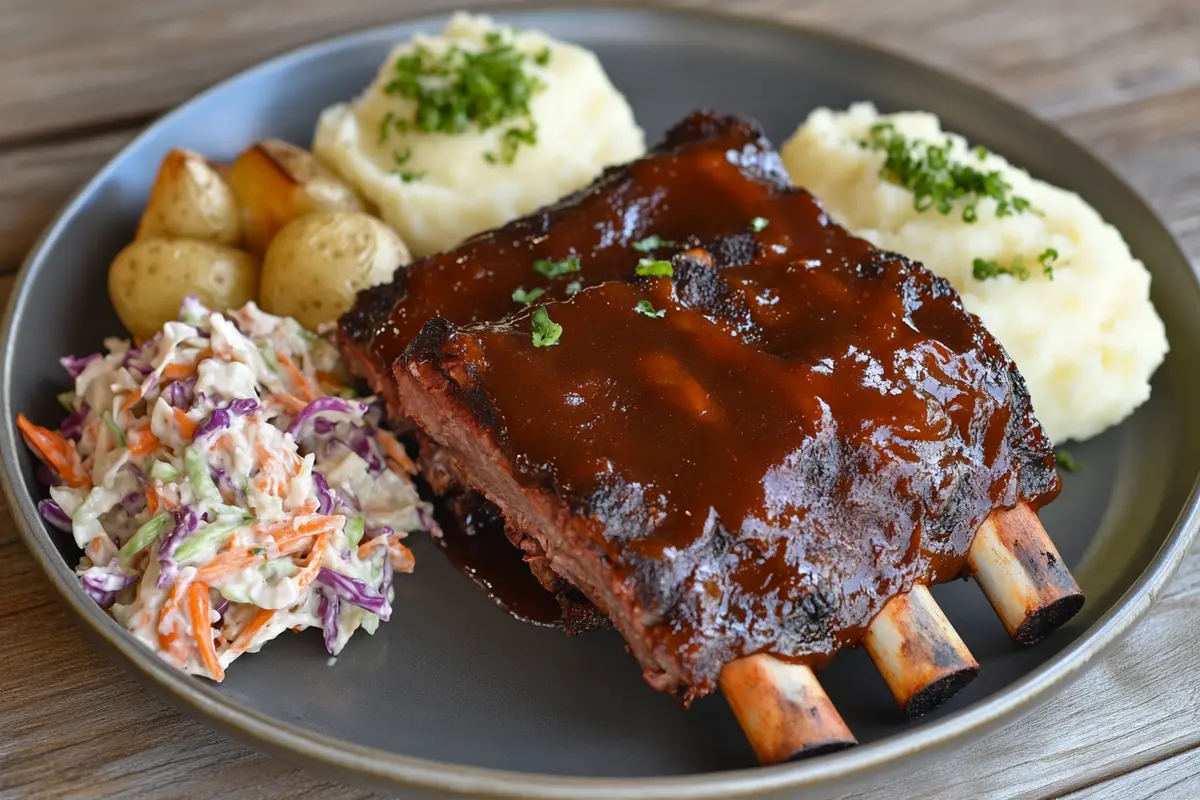Beef back ribs are a flavorful cut of meat that can transform an ordinary meal into a finger-licking feast. Whether you’re an avid BBQ enthusiast or just love hearty home-cooked dishes, beef back ribs deserve a place in your culinary repertoire. This article delves into what makes beef back ribs so special, explores their nutritional benefits, and shares cooking techniques, marinades, and recipes to make them shine. Ready to dive into the delicious world of beef back ribs? Let’s get started!
Introduction and Basics
What Are Beef Back Ribs Good For?
Beef back ribs are incredibly versatile, offering a rich, beefy flavor that’s perfect for grilling, slow-cooking, or baking. Unlike short ribs, which are meatier, beef back ribs have less meat but a tantalizing marbling of fat that renders down beautifully during cooking. This marbling creates a deep, smoky flavor that pairs perfectly with BBQ sauces, dry rubs, or simple salt and pepper seasoning.
These ribs aren’t just a favorite among BBQ lovers; they’re also ideal for those looking for a cost-effective yet delicious cut of beef. From casual family dinners to outdoor cookouts, beef back ribs are sure to impress.
What Are Beef Back Ribs?
Beef back ribs come from the upper section of the cow’s ribcage, situated closer to the spine. These ribs are typically removed during the process of cutting ribeye steaks or prime rib roasts. As a result, the meat left on the ribs is minimal but incredibly flavorful.
Despite their leaner nature, beef back ribs are prized for their ability to soak up marinades and rubs while delivering that classic beefy taste. Their long bones, often referred to as “dinosaur bones,” make for an eye-catching presentation on the plate.
The Unique Flavor Profile of Beef Back Ribs
What makes beef back ribs truly unique is their robust flavor. The meat, though sparse, carries the essence of prime rib, which is one of the most coveted cuts in the beef world. When cooked low and slow, the connective tissues break down, leaving the meat tender and succulent.
Different cooking techniques can enhance their flavor in unique ways:
- Grilling gives them a smoky, charred taste.
- Slow-cooking produces a fall-off-the-bone texture.
- Oven-baking creates a crisp, golden crust that locks in the juices.
The versatility of beef back ribs makes them an excellent choice for experimenting with various flavor profiles, from sweet and tangy BBQ to bold and spicy dry rubs.
Cooking Methods and Recipes
Best Cooking Methods for Beef Back Ribs
Cooking beef back ribs to perfection requires understanding the right techniques. Whether you’re after a smoky char or a fall-off-the-bone texture, there’s a method to suit every taste. Here’s how you can master the art of preparing beef back ribs.
Grilling Beef Back Ribs
Grilling is one of the most popular ways to cook beef back ribs. The high heat and smoky environment create a tantalizing crust that enhances their natural flavor.
- Preparation: Start by trimming excess fat and silverskin. A dry rub made of paprika, garlic powder, and brown sugar works wonders.
- Grill Setup: Preheat your grill for indirect cooking. Place a drip pan beneath the grill grates and maintain a temperature of about 275°F.
- Cooking Tips: Cook the ribs bone-side down for 1.5 to 2 hours. Brush them with BBQ sauce in the last 15 minutes for a caramelized finish.
For more detailed tips on grilling, check out How to Cook Beef Ribs Perfectly to achieve restaurant-quality results.
Slow-Cooking Beef Back Ribs
If you’re looking for unmatched tenderness, slow-cooking is the way to go. This method allows the meat to absorb flavors while becoming irresistibly soft.
- Preparation: Marinate the ribs overnight for the best results. Use a mix of soy sauce, honey, garlic, and black pepper for a sweet and savory profile.
- Cooking Process: Arrange the ribs in a slow cooker with a splash of beef broth or apple cider vinegar. Cook on low for 6-8 hours.
- Pro Tip: Finish them in the oven at 400°F for 10 minutes to create a crispy outer layer.

Oven-Baking Beef Back Ribs
When the grill isn’t an option, oven-baking delivers excellent results. It’s a convenient and foolproof method for achieving crispy, juicy ribs.
- Step 1: Preheat your oven to 300°F. Line a baking sheet with foil and place a wire rack on top.
- Step 2: Coat the ribs with a dry rub and wrap them tightly in foil. Bake for 2.5 to 3 hours.
- Step 3: Unwrap the ribs, brush them with BBQ sauce, and broil for 5-10 minutes for a caramelized crust.

Popular Recipes Using Beef Back Ribs
Beef back ribs are incredibly versatile, allowing you to experiment with various cuisines and flavors. Here are some must-try recipes:
- BBQ Beef Back Ribs: A classic favorite, perfect for outdoor cookouts.
- Smoky Flavored Ribs: Ideal for a backyard smoker, with a blend of hickory and mesquite wood chips.
- Korean-Style Ribs: A sweet and savory delight, marinated in soy sauce, sesame oil, and brown sugar.
Each recipe brings out the best in beef back ribs, offering a delicious option for any occasion.
Marinades and Rubs for Beef Back Ribs
A good marinade or rub can elevate your ribs to the next level. Here’s how to create the perfect base for your ribs:
- Dry Rub: Mix salt, black pepper, smoked paprika, onion powder, and cayenne pepper for a classic BBQ flavor.
- Marinade: Combine Worcestershire sauce, minced garlic, olive oil, and a hint of lemon juice to tenderize the meat while adding a zesty kick.
- Timing: Marinate for at least 6 hours, but overnight marination ensures deeper flavor penetration.

Benefits and Pairings
Nutritional Benefits of Beef Back Ribs
Beef back ribs aren’t just a treat for your taste buds they also pack a nutritional punch. While they’re often seen as indulgent, they offer a range of health benefits when consumed in moderation.
- Rich in Protein: One serving of beef back ribs provides a significant dose of high-quality protein, essential for muscle repair and growth.
- Packed with Minerals: These ribs are a great source of iron, zinc, and phosphorus, all of which support vital bodily functions like oxygen transportation and bone health.
- Collagen Content: The connective tissues in beef back ribs are rich in collagen, which may promote joint health and improve skin elasticity.
While they’re higher in fat compared to lean cuts, the marbled fat contributes to their rich flavor and should be enjoyed occasionally as part of a balanced diet.
What to Serve with Beef Back Ribs?
Pairing beef back ribs with the right side dishes takes your meal to the next level. Here are some perfect accompaniments:
- Classic Coleslaw: The tangy crunch of coleslaw balances the richness of the ribs.
- Mashed Potatoes: Creamy and buttery, they’re a comfort food staple.
- Cornbread: A slightly sweet bread that complements BBQ ribs beautifully.
- Grilled Vegetables: Adding a smoky flavor, grilled zucchini, bell peppers, and asparagus work wonderfully.
When it comes to sauces, tangy BBQ, mustard-based dips, or even garlic aioli can elevate the flavor profile of your ribs.
Are Beef Back Ribs Worth the Effort?
Absolutely! While cooking beef back ribs may require some patience, the payoff is well worth it. Here’s why they’re a favorite among food lovers:
- Affordable Alternative: Compared to prime rib or short ribs, beef back ribs are cost-effective without compromising on flavor.
- Versatile Cooking Options: From grilling to oven-baking, you can adapt the cooking method to suit your time and resources.
- Crowd-Pleaser: Their bold flavor and impressive presentation make them a hit at gatherings.
If you’re looking to elevate your culinary skills or simply enjoy a hearty, satisfying meal, beef back ribs are a fantastic choice.
Additional Tips for Perfect Beef Back Ribs
How to Choose the Best Beef Back Ribs?
Selecting high-quality beef back ribs is the first step to ensuring a successful dish. Here’s what to look for when shopping:
- Meat Coverage: While beef back ribs naturally have less meat, look for racks with a decent amount of flesh between the bones. Avoid overly trimmed ribs.
- Marbling: Fine lines of fat throughout the meat contribute to flavor and tenderness when cooked.
- Freshness: Opt for ribs with a bright red color and no strong odor, which indicates freshness.
If buying frozen ribs, ensure they’re vacuum-sealed to prevent freezer burn.
Preparing Beef Back Ribs for Cooking
Prepping your ribs properly ensures they turn out flavorful and tender. Follow these simple steps:
- Remove the Membrane: The silver skin on the back of the ribs can make them chewy. Slide a knife under the membrane, grip it with a paper towel, and pull it off.
- Trim Excess Fat: While some fat is desirable for flavor, trimming thick chunks helps avoid greasiness.
- Season Generously: Beef back ribs benefit from bold seasoning. Use a mix of salt, pepper, and aromatic spices or let them sit in a marinade for a few hours.
Enhancing Flavor with Smoking Techniques
Smoking beef back ribs adds an irresistible depth of flavor. If you have access to a smoker, here’s how to achieve perfection:
- Wood Choices: Hickory and mesquite impart a strong smoky flavor, while fruit woods like apple or cherry add a touch of sweetness.
- Temperature: Maintain a consistent temperature of 225°F to 250°F.
- Time: Smoke the ribs for 4–6 hours, basting occasionally with your favorite BBQ sauce.
Smoking creates a tender, fall-off-the-bone texture while infusing the ribs with a mouthwatering smoky aroma.
Storage and Reheating Tips
Cooked beef back ribs can be stored and reheated without losing their deliciousness.
- Storage: Refrigerate in an airtight container for up to 3 days or freeze for up to 3 months.
- Reheating: Wrap the ribs in foil and reheat in the oven at 300°F for about 20 minutes. Add a fresh brush of BBQ sauce to retain moisture.
Popular Variations of Beef Back Ribs
BBQ Beef Back Ribs
Nothing says classic comfort food like BBQ beef back ribs. The smoky aroma combined with a tangy, caramelized glaze makes this a go-to recipe for family dinners or backyard parties.
- Preparation: Marinate the ribs with a mix of garlic powder, smoked paprika, and a touch of brown sugar.
- Cooking: Grill or bake at a low temperature, brushing generously with BBQ sauce in the final stages of cooking.
- Serving Tip: Pair with cornbread and coleslaw for a quintessential BBQ experience.
Smoky Flavored Beef Back Ribs
Smoking brings out the deep, rich flavors of beef back ribs. This technique is particularly popular for those who enjoy a melt-in-your-mouth texture.
- Preparation: Rub the ribs with a mix of kosher salt, cracked pepper, and ground cumin.
- Smoking Process: Use wood chips like hickory or mesquite for a bold flavor. Smoke low and slow at 225°F to 250°F for 4–6 hours.
- Pro Tip: A water pan inside the smoker helps keep the ribs moist during cooking.
Korean-Style Beef Back Ribs
For a sweet and savory twist, Korean-style beef back ribs offer a delectable alternative to traditional BBQ.
- Marinade: Combine soy sauce, sesame oil, brown sugar, garlic, and ginger. Let the ribs soak overnight.
- Cooking: Grill on medium heat until the ribs are slightly charred and cooked through.
- Serving Tip: Garnish with toasted sesame seeds and chopped green onions for an authentic touch.
Oven-Baked Crispy Ribs
When grilling or smoking isn’t an option, oven-baked ribs are a fantastic alternative. With a crispy crust and tender meat, these ribs are a hit every time.
- Step 1: Preheat your oven to 300°F. Place seasoned ribs on a baking tray lined with foil.
- Step 2: Wrap tightly in foil and bake for 2.5 to 3 hours.
- Step 3: Finish under the broiler for a golden, crispy crust, brushing with BBQ sauce if desired.
Pairing Sauces and Dips
The right sauce or dip can elevate your beef back ribs to the next level. Here are some popular options:
- Classic BBQ Sauce: A tangy, smoky blend perfect for traditional BBQ ribs.
- Mustard-Based Sauce: Adds a zesty kick, balancing the richness of the meat.
- Garlic Aioli: A creamy, flavorful dip for those who prefer subtle, savory notes.
FAQs
What Are Beef Back Ribs Best Used For?
Beef back ribs are best used in recipes that highlight their rich, beefy flavor. From slow-cooked dishes to smoky BBQs, they’re ideal for creating comforting, hearty meals. Their versatility allows them to shine as a main course paired with sides or as an ingredient in stews and soups.
How Do You Make Beef Back Ribs Tender?
Tender beef back ribs are all about the cooking method. Slow-cooking at a low temperature is key. This breaks down the connective tissues, resulting in tender, juicy meat. Marinating beforehand and allowing the ribs to rest after cooking also enhances their texture and flavor.
Can Beef Back Ribs Be Cooked in an Air Fryer?
Yes, beef back ribs can be cooked in an air fryer! Season the ribs with your preferred rub or marinade, then cook at 375°F for about 15–20 minutes, flipping halfway through. Finish with a brush of BBQ sauce for a caramelized touch.
How Long Should You Cook Beef Back Ribs?
The cooking time depends on the method. For grilling or oven-baking, aim for 1.5 to 2.5 hours at a low temperature. Slow-cooking may take 6–8 hours on low heat. Always check for tenderness before serving.
Conclusion
Beef back ribs are a versatile, flavorful, and satisfying cut of meat that can elevate any meal. Whether you’re grilling them for a smoky BBQ, slow-cooking for tender perfection, or baking for a crispy crust, these ribs never fail to impress. Their bold taste, paired with the right marinades, rubs, and side dishes, makes them a crowd-pleaser for any occasion. With the tips, recipes, and variations shared here, you’re well-equipped to create mouthwatering beef back ribs that will leave everyone asking for seconds. So, roll up your sleeves, fire up your grill or oven, and enjoy the hearty goodness of beef back ribs!

